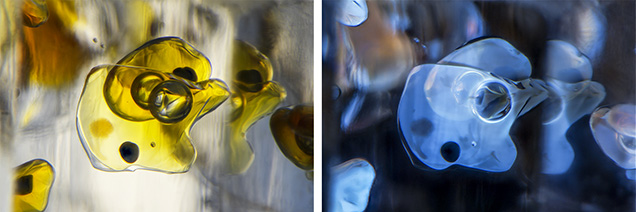New Find of Petroleum-Included Quartz from Madagascar

At the Tucson Gem and Mineral Show (TGMS), a new find of quartz with petroleum inclusions was offered for sale by Hidden Gem Gallery (Portland, Oregon). According to owner G. Moses Samora, the material is from the Andranotokana Massif in the Alaotra-Mangoro region of eastern Madagascar. Petroleum inclusions in quartz have been seen for a number of years from many deposits, most notably from Baluchistan, Pakistan (Spring 2004 Gem News International, pp. 79–80). The petroleum in these quartz crystals from Madagascar appeared brownish yellow and, as with many other petroleum inclusions in quartz, reacted to long-wave UV light with yellow to blue fluorescence (figure 1).

Microscopic examination revealed numerous complex fluid inclusions containing obvious brownish yellow petroleum, a gas bubble presumed to be methane, dark solids of what was likely asphaltite, and a colorless immiscible liquid that was probably water (figure 2). Interestingly, in some fluid inclusions the methane bubble was mobile provided there was enough available space within the petroleum-filled cavities. These components are consistent with petroleum fluid inclusions in quartz from other deposits. When exposed to long-wave UV light, the petroleum component strongly fluoresced light yellow (which appeared blue in the photomicrographs), as has been previously observed in similar material. The two crystals from this new deposit displayed a scepter morphology, which seems unusual, though it remains unclear whether this is diagnostic for the locality or just unique to these specific examples.
Microscopic inclusions in quartz are enjoyable to examine, and petroleum inclusions are of particular interest to the collector due to their spectacular UV reaction. The introduction of this new quartz find at the Tucson show is an exciting addition to the gem and mineral trade.
.jpg)


